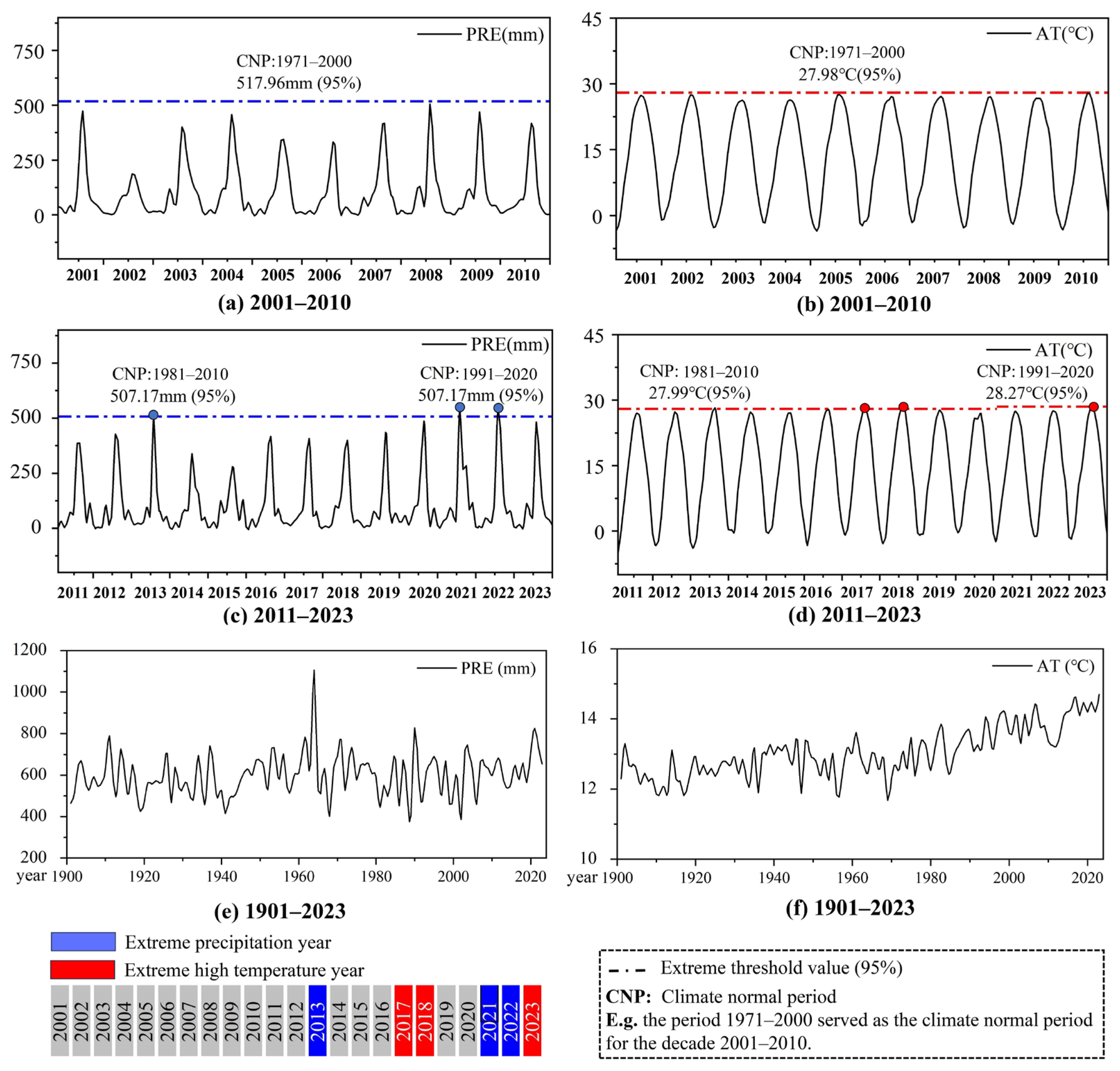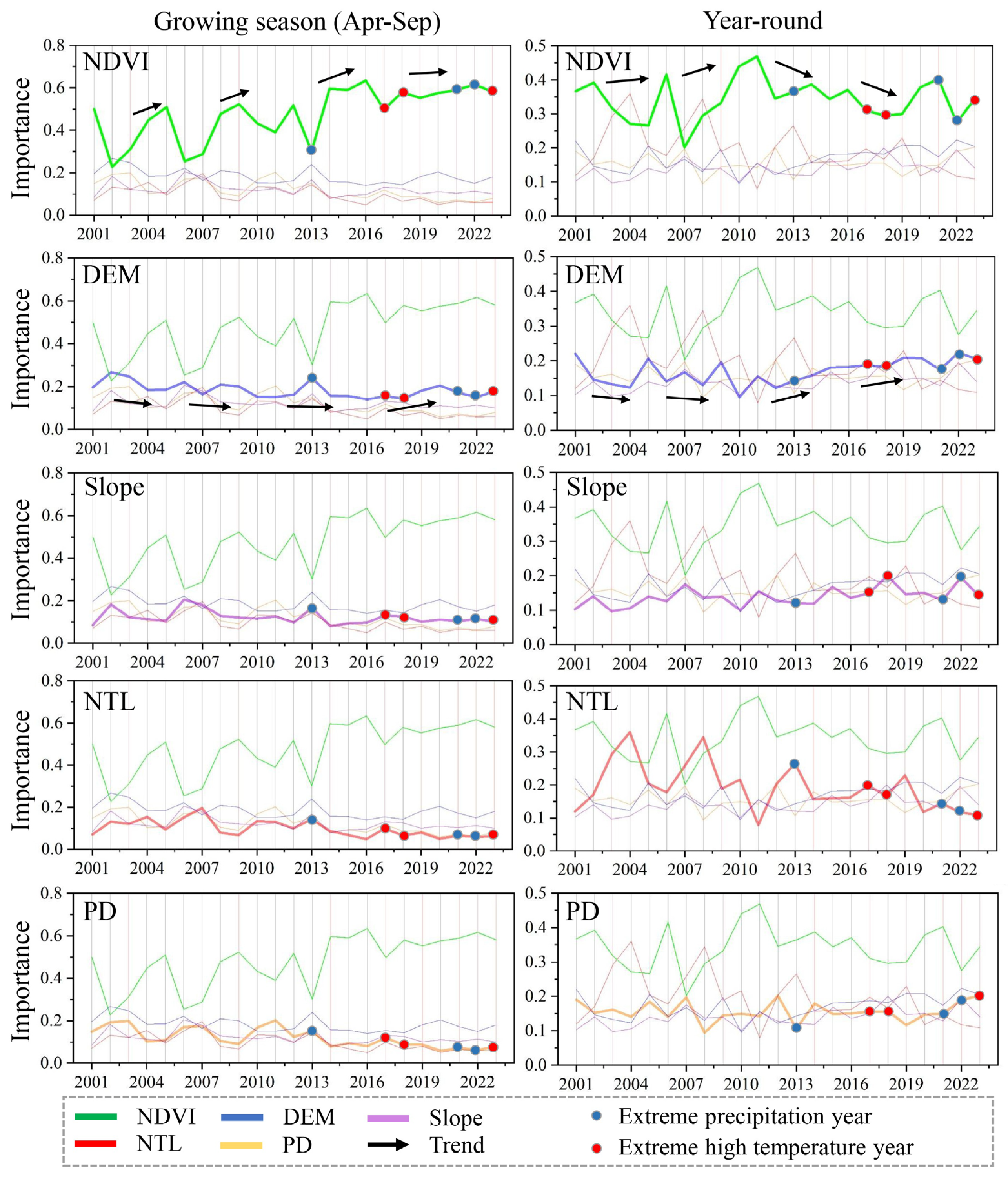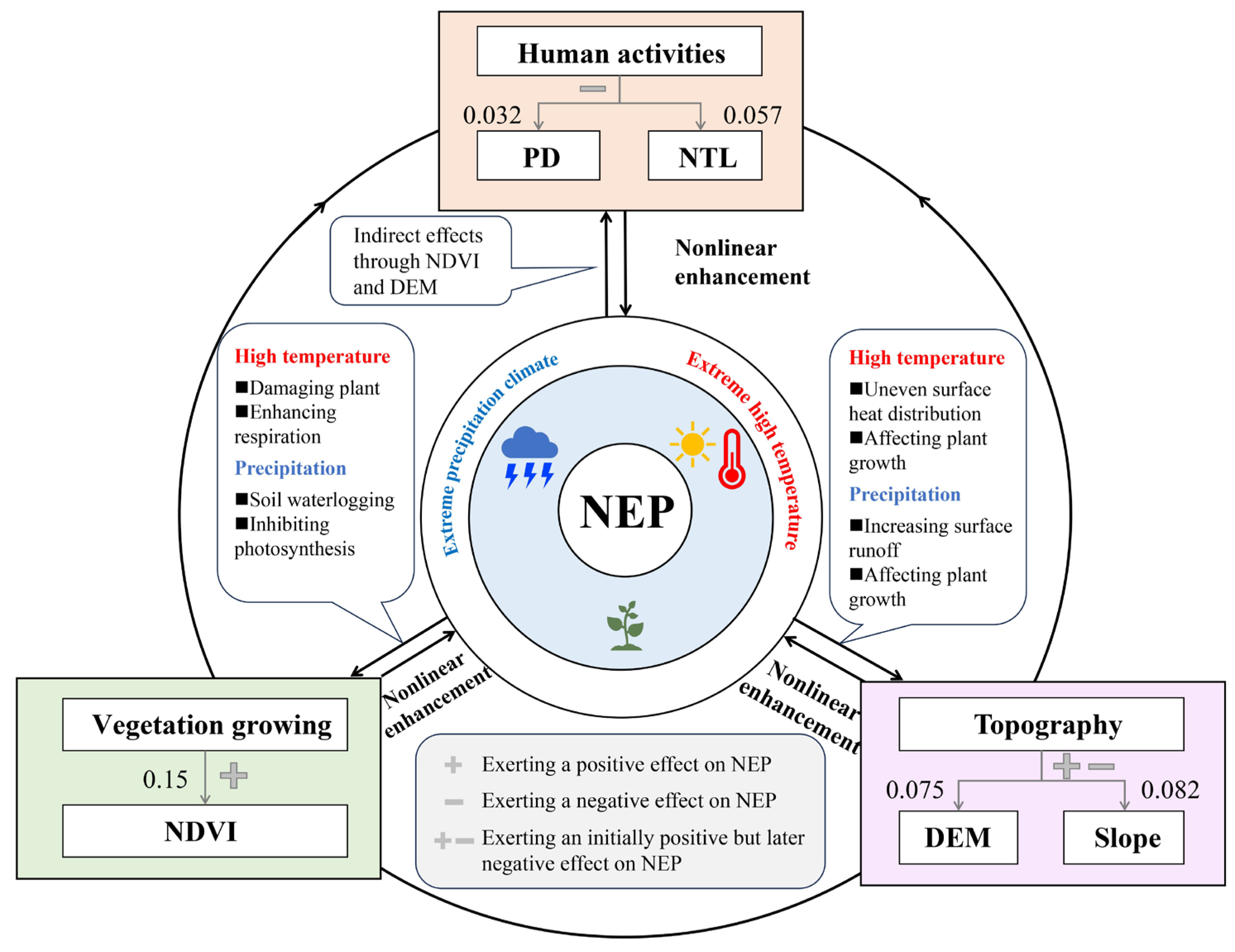Spatiotemporal Dynamics of NEP and Its Influencing Factors: Exploring the Impact Mechanisms Under Extreme Climate Conditions
Highlights
- NEP in Dongying showed an overall increasing but fluctuating trend from 2001 to 2023, with growth momentum weakening after 2017 due to increased extreme climate events.
- Extreme climate events reduced the positive role of NDVI and enhanced the negative influence of DEM on NEP, further constraining the potential for carbon sequestration since 2017.
- Extreme climate events were a critical driver of NEP changes, highlighting the need to quantify their impacts to support China’s “Dual Carbon” goals.
- The altered factor contributions underscore the importance of multi-factor synergy under climate extremes, providing key insights for adaptive ecosystem management.
Abstract
1. Introduction
2. Materials and Methods
2.1. Study Area
2.2. Data Sources
2.3. Research Framework
2.4. Methods
2.4.1. Data Preprocessing
- (1)
- NEP
- (2)
- Key factors
2.4.2. Spatiotemporal Trend Analysis of NEP
2.4.3. Analysis of Driving Factors and Impact Mechanisms of NEP
2.4.4. Interactive Effects of Various Factors on NEP Under Extreme Climate Conditions
- (1)
- Definition of extreme climate years
- (2)
- Analysis of Interaction Mechanisms
- (3)
- Analysis of lag effects
3. Results
3.1. Spatiotemporal Dynamics of NEP from 2001 to 2023
3.2. Potential Key Factors and Their Explanatory Power for NEP
3.2.1. Potential Key Factors
3.2.2. Interactive Effects of Multi-Factors on NEP
3.2.3. Response Patterns of Key Factors Related to NEP
3.3. Impacts of Extreme Climate Conditions on NEP
3.3.1. Distribution of Extreme Climate
3.3.2. Effects of Extreme Climate
3.3.3. Lag Effects of Extreme Climate
4. Discussion
4.1. Interactive Effects of Factors: Key to Decoding NEP Dynamics
4.2. Potential Mechanisms Under Extreme Climate Conditions
- (1)
- NDVI
- (2)
- DEM and Slope
- (3)
- PD and NTL
4.3. Limitations and Uncertainty
5. Conclusions
Author Contributions
Funding
Data Availability Statement
Acknowledgments
Conflicts of Interest
Abbreviations
| NEP | Net ecosystem productivity |
| NDVI | Normalized difference vegetation index |
| DEM | Digital elevation model |
| PRE | Precipitation |
| AT | Air temperature |
| PD | Population density |
| NTL | Nighttime light |
| NEE | Net ecosystem exchange |
References
- Chapin, F.S.; Woodwell, G.M.; Randerson, J.T.; Rastetter, E.B.; Lovett, G.M.; Baldocchi, D.D.; Clark, D.A.; Harmon, M.E.; Schimel, D.S.; Valentini, R.; et al. Reconciling Carbon-Cycle Concepts, Terminology, and Methods. Ecosystems 2006, 9, 1041–1050. [Google Scholar] [CrossRef]
- Liu, Q.; Peng, C.; Schneider, R.; Cyr, D.; McDowell, N.G.; Kneeshaw, D. Drought-Induced Increase in Tree Mortality and Corresponding Decrease in the Carbon Sink Capacity of Canada’s Boreal Forests from 1970 to 2020. Glob. Chang. Biol. 2023, 29, 2274–2285. [Google Scholar] [CrossRef]
- Yi, K.; Zhang, J.; Lei, H.; Chen, W.; Zhang, Y.; Fu, S.; Wang, K. Response of Ecological Condition in Ecologically Fragile Areas to Disturbance from Extreme Precipitation Event: An Empirical Analysis from the Loess Plateau. J. Clean. Prod. 2025, 512, 145701. [Google Scholar] [CrossRef]
- Bar-On, Y.M.; Li, X.; O’Sullivan, M.; Wigneron, J.P.; Sitch, S.; Ciais, P.; Frankenberg, C.; Fischer, W.W. Recent Gains in Global Terrestrial Carbon Stocks Are Mostly Stored in Nonliving Pools. Science 2025, 387, 1291–1295. [Google Scholar] [CrossRef]
- Wigneron, J.-P.; Li, X.; Frappart, F.; Fan, L.; Al-Yaari, A.; De Lannoy, G.; Liu, X.; Wang, M.; Le Masson, E.; Moisy, C. SMOS-IC data record of soil moisture and L-VOD: Historical development, applications and perspectives. Remote Sens. Environ. 2021, 254, 112238. [Google Scholar] [CrossRef]
- Zhao, L.; Zhang, C.; Wang, Q.; Yang, C.; Suo, X.; Zhang, Q. Climate Extremes and Land Use Carbon Emissions: Insight from the Perspective of Sustainable Land Use in the Eastern Coast of China. J. Clean. Prod. 2024, 452, 142219. [Google Scholar] [CrossRef]
- Feldman, A.F.; Konings, A.G.; Gentine, P.; Cattry, M.; Wang, L.; Smith, W.K.; Biederman, J.A.; Chatterjee, A.; Joiner, J.; Poulter, B. Large Global-Scale Vegetation Sensitivity to Daily Rainfall Variability. Nature 2024, 636, 380–384. [Google Scholar] [CrossRef]
- Meng, Z.; Guan, Y.; Feng, Y. Simulating the Impact of Typhoons on Air—Sea Co2 Fluxes on the Northern Coastal Area of the South China Sea. Environ. Res. Lett. 2024, 19, 044008. [Google Scholar] [CrossRef]
- Resplandy, L.; Hogikyan, A.; Müller, J.D.; Najjar, R.G.; Bange, H.W.; Bianchi, D.; Weber, T.; Cai, W.-J.; Doney, S.C.; Fennel, K.; et al. A Synthesis of Global Coastal Ocean Greenhouse Gas Fluxes. Glob. Biogeochem. Cycles 2024, 38, e2023GB007803. [Google Scholar] [CrossRef]
- Choudhary, B.; Dhar, V.; Pawase, A.S. Blue Carbon and the Role of Mangroves in Carbon Sequestration: Its Mechanisms, Estimation, Human Impacts and Conservation Strategies for Economic Incentives. J. Sea Res. 2024, 199, 102504. [Google Scholar] [CrossRef]
- Liu, X.; Zhang, R.; Guo, J.; Xu, H.; Miao, Y.; Niu, F.; Gao, Z.; Yang, X.; Xiong, F.; Zhang, J. Analysis of the Spatiotemporal Dynamics of Grassland Carbon Sinks in Xinjiang Via the Improved Casa Model. Ecol. Indic. 2025, 170, 113062. [Google Scholar] [CrossRef]
- Jiang, C.; Wu, Z.; Cheng, J.; Yu, Q. Impacts of Urbanization on Net Primary Productivity in the Pearl River Delta, China. Int. J. Plant Prod. 2015, 9, 581–598. [Google Scholar]
- Xiao, X.; Hollinger, D.; Aber, J.; Goltz, M.; Davidson, E.A.; Zhang, Q.; Moore, B. Satellite-Based Modeling of Gross Primary Production in an Evergreen Needleleaf Forest. Remote Sens. Environ. 2004, 89, 519–534. [Google Scholar] [CrossRef]
- Wei, D.; Tao, J.; Wang, Z.; Zhao, H.; Zhao, W.; Wang, X. Elevation-dependent pattern of net CO2 uptake across China. Nat. Commun. 2024, 15, 2489. [Google Scholar] [CrossRef]
- McLeod, E.; Chmura, G.L.; Bouillon, S.; Salm, R.; Björk, M.; Duarte, C.M.; Lovelock, C.E.; Schlesinger, W.H.; Silliman, B.R. A Blueprint for Blue Carbon: Toward an Improved Understanding of the Role of Vegetated Coastal Habitats in Sequestering CO2. Front. Ecol. Environ. 2011, 9, 552–560. [Google Scholar] [CrossRef]
- Valentine, K.; Herbert, E.R.; Walters, D.C.; Chen, Y.; Smith, A.J.; Kirwan, M.L. Climate-Driven Tradeoffs between Landscape Connectivity and the Maintenance of the Coastal Carbon Sink. Nat. Commun. 2023, 14, 1137. [Google Scholar] [CrossRef] [PubMed]
- Wang, Z.; Zhang, J.; Luo, P.; Sun, D.; Li, J. Revealing the Spatio-Temporal Characteristics and Impact Mechanism of Carbon Emission in China’s Urban Agglomerations. Urban Clim. 2023, 52, 101733. [Google Scholar] [CrossRef]
- Tang, S.; Tian, D.; Wang, J.; Zhang, R.; Wang, S.; Song, J.; Wan, S.; Zhang, J.; Zhang, S.; Li, Z.; et al. Synergistic Effects of Multiple Global Change Drivers on Terrestrial Ecosystem Carbon Sink. Sci. Total Environ. 2024, 906, 167554. [Google Scholar] [CrossRef] [PubMed]
- Buttlar, J.v.; Zscheischler, J.; Rammig, A.; Sippel, S.; Reichstein, M.; Knohl, A.; Jung, M.; Menzer, O.; Arain, M.A.; Buchmann, N.; et al. Impacts of Droughts and Extreme Temperature Events on Gross Primary Production and Ecosystem Respiration: A Systematic Assessment across Ecosystems and Climate Zones. Biogeosciences Discuss. 2018, 15, 1293–1318. [Google Scholar] [CrossRef]
- Liu, L.; Zhang, X. Glc_Fcs10: Global 10 M Land-Cover Dataset with Fine Classification System from Sentinel-1 and 2 Time-Series Data. Zenodo 2025, 17, 14729665. [Google Scholar]
- Khan, S.; Juvigny-Khenafou, N.P.D.; Dalu, T.; Milham, P.J.; Hamid, Y.; Eltohamy, K.M.; Ullah, H.; Amiri, B.J.; Chen, H.; Wu, N. The Influence of Ph and Temperature on Benthic Chlorophyll-A: Insights from Shap-Xgboost and Random Forest Models. Ecol. Inform. 2025, 91, 103355. [Google Scholar] [CrossRef]
- Zhang, J.; Hao, X.; Hao, H.; Fan, X.; Li, Y. Climate Change Decreased Net Ecosystem Productivity in the Arid Region of Central Asia. Remote Sens. 2021, 13, 4449. [Google Scholar] [CrossRef]
- Guo, X.; Liu, Y.; Xie, T.; Li, Y.; Liu, H.; Wang, Q. Impact of Ecological Restoration on Carbon Sink Function in Coastal Wetlands: A Review. Water 2025, 17, 488. [Google Scholar] [CrossRef]
- Herbert, E.R.; Windham-Myers, L.; Kirwan, M.L. Sea-Level Rise Enhances Carbon Accumulation in United States Tidal Wetlands. One Earth 2021, 4, 425–433. [Google Scholar] [CrossRef]
- Huang, N.; Wang, L.; Zhang, Y.; Gao, S.; Niu, Z. Estimating the Net Ecosystem Exchange at Global Fluxnet Sites Using a Random Forest Model. IEEE J. Sel. Top. Appl. Earth Obs. Remote Sens. 2021, 14, 9826–9836. [Google Scholar] [CrossRef]
- Wen, C.; Long, T.; He, G.; Jiao, W.; Jiang, W. Temporally enhanced RSEI and nighttime lights reveal long-term ecological changes and effective protection in China’s inaugural national parks. Ecol. Indic. 2025, 170, 112981. [Google Scholar] [CrossRef]
- Sen, P.K. Estimates of the Regression Coefficient Based on Kendall’s Tau. J. Am. Stat. Assoc. 1968, 63, 1379–1389. [Google Scholar] [CrossRef]
- Okafor, C.G.; Jimoh, O.D.; Larbi, K.I. Detecting Changes in Hydro-Climatic Variables During the Last Four Decades (1975–2014) on Downstream Kaduna River Catchment, Nigeria. Atmos. Clim. Sci. 2017, 7, 161–175. [Google Scholar] [CrossRef]
- Wang, J.-F.; Li, X.-H.; Christakos, G.; Liao, Y.-L.; Zhang, T.; Gu, X.; Zheng, X.-Y. Geographical Detectors--Based Health Risk Assessment and Its Application in the Neural Tube Defects Study of the Heshun Region, China. Int. J. Geogr. Inf. Sci. 2010, 24, 107–127. [Google Scholar] [CrossRef]
- Zhang, Z.; Song, Y.; Wu, P. Robust Geographical Detector. Int. J. Appl. Earth Obs. Geoinf. 2022, 109, 102782. [Google Scholar] [CrossRef]
- Kovačević, J.; Cvijetinović, Ž.; Lakušić, D.; Kuzmanović, N.; Šinžar-Sekulić, J.; Mitrović, M.; Stančić, N.; Brodić, N.; Mihajlović, D. Spatio-Temporal Classification Framework for Mapping Woody Vegetation from Multi-Temporal Sentinel-2 Imagery. Remote Sens. 2020, 12, 2845. [Google Scholar] [CrossRef]
- Saki, S.A.; Sofia, G.; Anagnostou, E.N. Characterizing Conus-Wide Spatio-Temporal Changes in Daily Precipitation, Flow, and Variability of Extremes. J. Hydrol. 2023, 626, 130336. [Google Scholar] [CrossRef]
- Zhou, M.; Zhou, S.; Hei, J.; Yang, S.; Liu, Q.; Yang, T.; Zhiqiang, W. Impact of innovation drivers in Chinese cities: Machine learning analysis using XGBoost. Cities 2025, 167, 106347. [Google Scholar] [CrossRef]
- Qi, S.; Zhang, H.; Zhang, M. Evolutionary characteristics of carbon sources/sinks in Chinese terrestrial ecosystems regarding to temporal effects and geographical partitioning. Ecol. Indic. 2024, 160, 111923. [Google Scholar] [CrossRef]
- He, L.; Wang, J.; Peltier, D.M.P.; Ritter, F.; Ciais, P.; Peñuelas, J.; Xiao, J.; Crowther, T.W.; Li, X.; Ye, J.-S.; et al. Lagged precipitation effects on plant production across terrestrial biomes. Nat. Ecol. Evol. 2025, 9, 1800–1811. [Google Scholar] [CrossRef]
- Yang, R.; Yuan, H.; Du, R.; Zhou, L.; Wu, J.; Gao, L.; Mao, T. Temperature-Vpd-Evapotranspiration Interactions Modulated Asynchronous Dynamics of Vegetation Photosynthesis and Net Ecosystem Production in Eurasia. Ecol. Indic. 2025, 174, 113445. [Google Scholar] [CrossRef]
- Hoylman, Z.H.; Jencso, K.G.; Hu, J.; Martin, J.T.; Holden, Z.A.; Seielstad, C.A.; Rowell, E.M. Hillslope Topography Mediates Spatial Patterns of Ecosystem Sensitivity to Climate. J. Geophys. Res. Biogeosci. 2018, 123, 353–371. [Google Scholar] [CrossRef]
- Zhang, Y.; Wang, Z.; Shi, X.; Sun, P.; Xiao, P.; Xu, J.; Shen, D. Impacts of Climate Change and Vegetation Greening Driven by Natural and Anthropogenic Factors on Carbon Sink in Chinese Loess Plateau after Ecological Restoration. Catena 2025, 258, 109310. [Google Scholar] [CrossRef]
- Wang, C.; Zhao, W.; Zhang, Y. The Change in Net Ecosystem Productivity and Its Driving Mechanism in a Mountain Ecosystem of Arid Regions, Northwest China. Remote Sens. 2022, 14, 4046. [Google Scholar] [CrossRef]
- Guo, D.; Song, X.; Hu, R.; Cai, S.; Zhu, X.; Hao, Y. Grassland Type-Dependent Spatiotemporal Characteristics of Productivity in Inner Mongolia and Its Response to Climate Factors. Sci. Total Environ. 2021, 775, 145644. [Google Scholar] [CrossRef]
- Adamsa, H.D.; Guardiola-Claramonte, M.; Barron-Gafford, G.A.; Villegas, J.C.; David, D.B.; Zoug, C.B.; Troch, P.A.; Huxman, T.E. Temperature Sensitivity of Drought-Induced Tree Mortality Portends Increased Regional Die-Off under Global-Change-Type Drought. Proc. Natl. Acad. Sci. USA 2009, 106, 7063–7066. [Google Scholar] [CrossRef]
- Zeng, Z.L.; Wang, X.Q.; Zhang, S.B.; Huang, W. Mesophyll Conductance Limits Photosynthesis in Fluctuating Light under Combined Drought and Heat Stresses. Plant Physiol. 2024, 194, 1498–1511. [Google Scholar] [CrossRef]
- Bernacchi, C.J.; Long, S.P.; Ort, D.R. Safeguarding Crop Photosynthesis in a Rapidly Warming World. Science 2025, 388, 1153–1160. [Google Scholar] [CrossRef]
- Chen, R.; Yin, G.; Liu, G.; Li, J.; Verger, A. Evaluation and Normalization of Topographic Effects on Vegetation Indices. Remote Sens. 2020, 12, 2290. [Google Scholar] [CrossRef]
- Tang, C.; Liu, Y.; Li, Z.; Guo, L.; Xu, A.; Zhao, J. Effectiveness of Vegetation Cover Pattern on Regulating Soil Erosion and Runoff Generation in Red Soil Environment, Southern China. Ecol. Indic. 2021, 129, 107956. [Google Scholar] [CrossRef]
- Xing, W.; Sun, G.; Zou, Z.; Li, Y.; Yang, P.; Ao, C. Mathematical Model of Ammonia Nitrogen Transport from Soil to Runoff on Irregular Slopes. J. Hydrol. 2023, 620, 129440. [Google Scholar] [CrossRef]
- Kang, J.; Zhang, Q.; Zhang, B.; Hu, Y.; Zhang, C.; Li, C. Dual Impacts of Urban Expansion on the Carbon Sequestration Capacity of Urban Vegetation: A Multi-Scale Global Study. Ecol. Indic. 2025, 176, 113746. [Google Scholar] [CrossRef]








| Type | Name | Time | Source |
|---|---|---|---|
| NEP | Landsat | 2001–2023 | USGS Earth Explorer |
| Sentinel | 2015–2023 | Copernicus Data Space Ecosystem | |
| NEE | 2022–2024 | Observed at flux tower stations | |
| AT | 2001–2023 | Measured at meteorological stations | |
| solar radiation | 2001–2023 | ||
| Influencing factors | PRE | 1901–2023 | https://data.tpdc.ac.cn/zh-hans/data/faae7605-a0f2-4d18-b28f-5cee413766a2 (accessed on 18 July 2025) |
| AT | 1901–2023 | https://data.tpdc.ac.cn/zh-hans/data/71ab4677-b66c-4fd1-a004-b2a541c4d5bf (accessed on 18 July 2025) | |
| DEM | 2015 | Copernicus PANDA https://doi.org/10.5069/G9028PQB (accessed on 23 July 2025) | |
| Slope | 2015 | Derived from DEM data | |
| NDVI | 2001–2023 | https://data.tpdc.ac.cn/zh-hans/data/10535b0b-8502-4465-bc53-78bcf24387b3 (accessed on 20 October 2025) | |
| PD | 2001–2023 | LandScan Global Population Database https://landscan.ornl.gov | |
| NTL | 2001–2023 | http://geodata.nnu.edu.cn |
| Number | Condition | Interaction Type |
|---|---|---|
| 1 | Nonlinear enhancement | |
| 2 | Bivariate enhancement | |
| 3 | Weakening | |
| 4 | Other | Independence |
| Parameter Set | Number of Trees | Max Depth | Learning Rate | Subsample | Colsaple _Bytree | R2 |
|---|---|---|---|---|---|---|
| Set1 | 100 | 6 | 0.1 | 0.8 | 0.8 | 0.605 |
| Set2 | 200 | 10 | 0.05 | 0.7 | 0.7 | 0.599 |
| Set3 | 300 | 4 | 0.01 | 0.9 | 0.9 | 0.586 |
| Set4 | 150 | 8 | 0.2 | 0.6 | 0.6 | 0.592 |
| Z | Types of Change Trends | Area Proportion | |
|---|---|---|---|
| 2.58 < |Z| | Highly significant increase | 15.7% | |
| 1.96 < |Z| ≤ 2.58 | Significant increase | 10.2% | |
| 1.65 < |Z| ≤ 1.96 | Slightly significant increase | 6.1% | |
| |Z| ≤ 1.65 | Non-significant increase | 42.9% | |
| |Z| | No change | 8.1% | |
| |Z| ≤ 1.65 | Non-significant decrease | 0 | |
| 1.65 < |Z| ≤ 1.96 | Slightly significant decrease | 3.1% | |
| 1.96 < |Z| ≤ 2.58 | Significant decrease | 5.1% | |
| 2.58 < |Z| | Highly significant decrease | 8.7% |
| Climate Change | Factors (Importance) | Correlation | Optimal Lag Month | p |
|---|---|---|---|---|
| PRE | NDVI | 0.276 | 1 | 0.000 |
| PRE | DEM | 0.461 | 11 | 0.000 |
| PRE | Slope | 0.404 | 11 | 0.000 |
| PRE | POP | 0.341 | 11 | 0.000 |
| PRE | NTL | −0.409 | 1 | 0.000 |
| AT | NDVI | 0.209 | 4 | 0.001 |
| AT | DEM | −0.536 | 6 | 0.000 |
| AT | Slope | −0.341 | 5 | 0.000 |
| AT | POP | −0.251 | 5 | 0.000 |
| AT | NTL | 0.437 | 6 | 0.000 |
Disclaimer/Publisher’s Note: The statements, opinions and data contained in all publications are solely those of the individual author(s) and contributor(s) and not of MDPI and/or the editor(s). MDPI and/or the editor(s) disclaim responsibility for any injury to people or property resulting from any ideas, methods, instructions or products referred to in the content. |
© 2025 by the authors. Licensee MDPI, Basel, Switzerland. This article is an open access article distributed under the terms and conditions of the Creative Commons Attribution (CC BY) license (https://creativecommons.org/licenses/by/4.0/).
Share and Cite
Wang, L.; Chen, W.; Song, W.; Huang, N.; Zhang, Y.; Li, G.; Zhang, X.; Peng, Y.; Niu, Z. Spatiotemporal Dynamics of NEP and Its Influencing Factors: Exploring the Impact Mechanisms Under Extreme Climate Conditions. Remote Sens. 2025, 17, 3633. https://doi.org/10.3390/rs17213633
Wang L, Chen W, Song W, Huang N, Zhang Y, Li G, Zhang X, Peng Y, Niu Z. Spatiotemporal Dynamics of NEP and Its Influencing Factors: Exploring the Impact Mechanisms Under Extreme Climate Conditions. Remote Sensing. 2025; 17(21):3633. https://doi.org/10.3390/rs17213633
Chicago/Turabian StyleWang, Li, Wei Chen, Wanjuan Song, Ni Huang, Yuelin Zhang, Guoxu Li, Xin Zhang, Yu Peng, and Zheng Niu. 2025. "Spatiotemporal Dynamics of NEP and Its Influencing Factors: Exploring the Impact Mechanisms Under Extreme Climate Conditions" Remote Sensing 17, no. 21: 3633. https://doi.org/10.3390/rs17213633
APA StyleWang, L., Chen, W., Song, W., Huang, N., Zhang, Y., Li, G., Zhang, X., Peng, Y., & Niu, Z. (2025). Spatiotemporal Dynamics of NEP and Its Influencing Factors: Exploring the Impact Mechanisms Under Extreme Climate Conditions. Remote Sensing, 17(21), 3633. https://doi.org/10.3390/rs17213633







